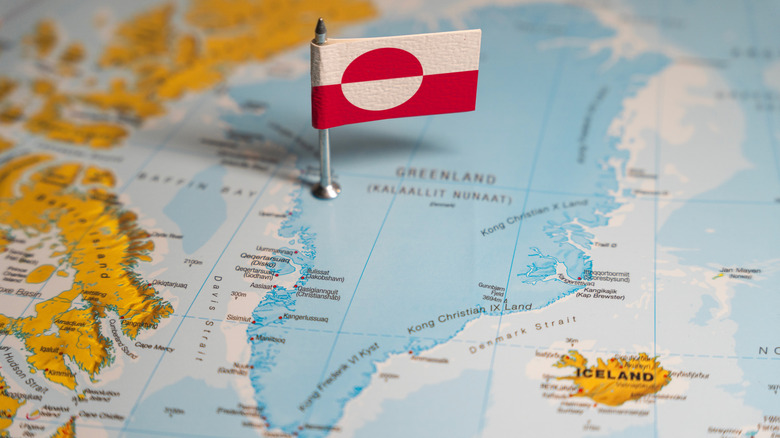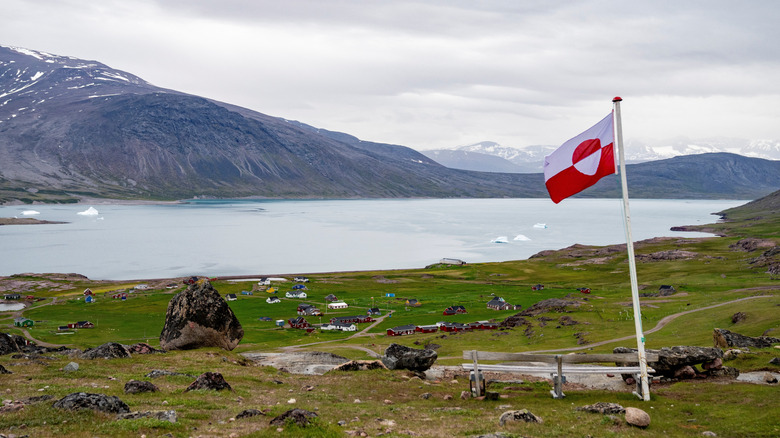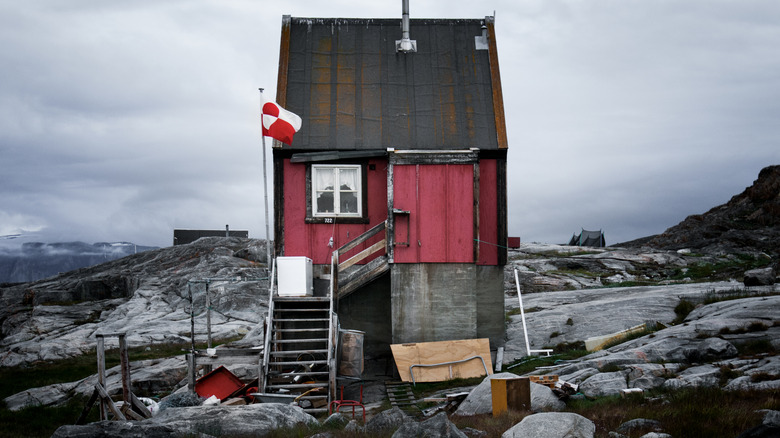What Does Greenland's Flag Symbolize?
Let's be honest: The most that many Americans know about Greenland is that it isn't green. Its name came from Erik Thorvaldsson, aka Erik the Red, a 10th-century Norwegian Viking who found Greenland while sailing and wanted to tempt people to settle it with him. Hence the appealing name: Greenland. But there's not a whole lot of land there that's not covered in ice, which is 80% of the region. This is true despite Greenland being a massive island with a coast 24,430-miles long. Despite the size, only about 56,000 people live there at present. Plus, Greenland is part of Denmark and not its own country, though it has seats in the Danish parliament. And then there's its interesting-looking flag with opposing colors of red and white.
It's a simple-enough-looking flag at first sight — modest, plain, and maybe mistaken for the Japanese flag's red circle against a white backdrop. And indeed, the circle in the center of Greenland's flag is also, like the Japanese flag, supposed to represent the sun. It specifically represents the setting sun that vanishes behind the horizon in winter and returns in spring — hence the inverted colors. This symbolism is especially meaningful for Arctic countries that are plunged into absolute darkness for months at a time. Then there's the colors themselves, which are the colors of the Danish flag but without the Danish cross. The lack of a cross represents the separation of Greenland from Danish culture and religion.
Greenland's flag embodies its long path to the present
Greenland's flag represents a culmination of the region's story, one designed and adopted only recently in 1985. The flag embodies the island's 4,500-year-old history of human habitation, going back to about 2,500 B.C.E. Starting then, various Inuit peoples — a collective term for the Indigenous peoples who occupy the Arctic and speak a variety of dialects — started island hopping from Canada to Greenland. One contemporary Inuit dialect is Kalaallisut, which is spoken in West Greenland and has become the region's standard language, Greenlandic. Greenlandic is reflected in the name of the island's capital, Nuuk, and the Inuit name for the whole island, Kalaallit Nunaat. Seventy percent of Greenland speaks Greenlandic, but it's Danish that dominates the country's political world.
And therein lies the heart of the second part of the Greenland story. While Norwegians like Erik the Red came across Greenland from 923 to 933 C.E., it wasn't until 1721 that Danish missionary Hans Egede founded both a Lutheran church and trading company near modern-day Nuuk. The Danish had been in contact with the Indigenous Inuit since the 16th century, and come 1776, they basically blocked other countries from dealing with the island.
This setup lasted until 1950, when Greenland was opened to the world following its brief stint of protection by the U.S. from 1941 to 1945. This happened after Germany's World War II occupation of Denmark in 1940. But it wasn't until 1979 that Greenland was allowed to govern itself as part of the Kingdom of Denmark. Its flag, designed six years later, depicts the tensions between Greenland and Denmark that define contemporary Greenland.
Artist and politician Thue Christiansen designed Greenland's flag
One year after Greenland was granted self-governance in 1979, aka "home rule," the island set about designing its flag. The region didn't have a flag of its own before then and used the Danish flag, the Dannebrog. It has a long history going back to 1219, when legend says the flag fell from the sky during a battle led by the Danish king, Valdemar Sejr. The Dannbrog's left-of-center white cross against a red background retains the exact same cross design as the Swedish, Norwegian, Icelandic, and Finnish flags — the Nordic nations — but each has different colors. The Faroe Islands use the same design, and they became an autonomous part of the Kingdom of Denmark in 1948, 31 years before Greenland.
Greenland almost joined the Nordic bunch with a white cross against a green background. That design was submitted by Sven Tito Achen, co-founder of the Scandinavian Heraldry Society, who wanted to connect Greenland to its neighboring nations. But out of the 600-plus flag submissions that Greenland's parliament sifted through, it was Thue Christiansen's split red-and-white circle flag that won out against Achen's 14 to 11 in 1985. Christiansen was one of Greenland's most famous visual artists and also served as Greenland's Minister of Culture and Education from 1979 to 1983. So it was that Greenland's Erfalasorput — "our flag" — was born, using the Danish colors in solidarity with Denmark, lacking a cross to show the connection to other Inuit, and employing its setting sun motif to show the nation's connection to the Arctic.


